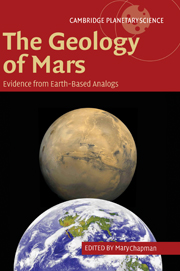Book contents
- Frontmatter
- Contents
- Preface: the rationale for planetary analog studies
- List of contributors
- 1 The geology of Mars: new insights and outstanding questions
- 2 Impact structures on Earth and Mars
- 3 Terrestrial analogs to the calderas of the Tharsis volcanoes on Mars
- 4 Volcanic features of New Mexico analogous to volcanic features on Mars
- 5 Comparison of flood lavas on Earth and Mars
- 6 Rootless volcanic cones in Iceland and on Mars
- 7 Mars interior layered deposits and terrestrial sub-ice volcanoes compared: observations and interpretations of similar geomorphic characteristics
- 8 Lava—sediment interactions on Mars: evidence and consequences
- 9 Eolian dunes and deposits in the western United States as analogs to wind-related features on Mars
- 10 Debris flows in Greenland and on Mars
- 11 Siberian rivers and Martian outflow channels: an analogy
- 12 Formation of valleys and cataclysmic flood channels on Earth and Mars
- 13 Playa environments on Earth: possible analogs for Mars
- 14 Signatures of habitats and life in Earth's high-altitude lakes: clues to Noachian aqueous environments on Mars
- 15 The Canyonlands model for planetary grabens: revised physical basis and implications
- 16 Geochemical analogs and Martian meteorites
- 17 Integrated analog mission design for planetary exploration with humans and robots
- Index
- Plate section
- References
15 - The Canyonlands model for planetary grabens: revised physical basis and implications
Published online by Cambridge University Press: 18 September 2009
- Frontmatter
- Contents
- Preface: the rationale for planetary analog studies
- List of contributors
- 1 The geology of Mars: new insights and outstanding questions
- 2 Impact structures on Earth and Mars
- 3 Terrestrial analogs to the calderas of the Tharsis volcanoes on Mars
- 4 Volcanic features of New Mexico analogous to volcanic features on Mars
- 5 Comparison of flood lavas on Earth and Mars
- 6 Rootless volcanic cones in Iceland and on Mars
- 7 Mars interior layered deposits and terrestrial sub-ice volcanoes compared: observations and interpretations of similar geomorphic characteristics
- 8 Lava—sediment interactions on Mars: evidence and consequences
- 9 Eolian dunes and deposits in the western United States as analogs to wind-related features on Mars
- 10 Debris flows in Greenland and on Mars
- 11 Siberian rivers and Martian outflow channels: an analogy
- 12 Formation of valleys and cataclysmic flood channels on Earth and Mars
- 13 Playa environments on Earth: possible analogs for Mars
- 14 Signatures of habitats and life in Earth's high-altitude lakes: clues to Noachian aqueous environments on Mars
- 15 The Canyonlands model for planetary grabens: revised physical basis and implications
- 16 Geochemical analogs and Martian meteorites
- 17 Integrated analog mission design for planetary exploration with humans and robots
- Index
- Plate section
- References
Summary
Introduction
For more than a quarter of a century, the spectacular grabens of Canyonlands National Park, Utah, have provided planetologists with a fundamental analog for understanding what planetary grabens should look like and – more importantly – what may be implied about the depth variation of mechanical properties and horizontal extensional strain.
The seminal work on Canyonlands grabens was done by George McGill and coworkers in support of their investigations of the origin and kinematic significance of lunar and Martian straight rilles (McGill, 1971; McGill and Stromquist, 1975, 1979; Stromquist, 1976; Wise, 1976). McGill and Stromquist (1979) hoped to invert graben widths, assessed on an aerial or orbital image, for the depth of faulting (i.e., fault intersection depth). By equating this depth with stratigraphic layer thickness and assuming a symmetric graben geometry and plausible values of fault dip angles, grabens provided ready and seemingly reliable probes of the near-surface planetary stratigraphy and strain. Interestingly, the analog modeling of brittle-layer extension over a ductile (quasiplastic) substrate, appropriate to Canyonlands stratigraphy (McGill and Stromquist, 1975, 1979), anticipated the key role of faulting in triggering and mobilizing salt or shale diapirism at depth (Jackson and Vendeville, 1994; Jackson, 1995). Other observations and inferences made in the 1970s, including flexure of rock layers at ramps near graben terminations and incremental growth of fault slip (McGill and Stromquist, 1979), anticipated these fundamentally important ideas by at least a decade (Sibson, 1989; Peacock and Sanderson, 1991; Cowie and Scholz, 1992).
- Type
- Chapter
- Information
- The Geology of MarsEvidence from Earth-Based Analogs, pp. 371 - 399Publisher: Cambridge University PressPrint publication year: 2007
References
- 15
- Cited by

